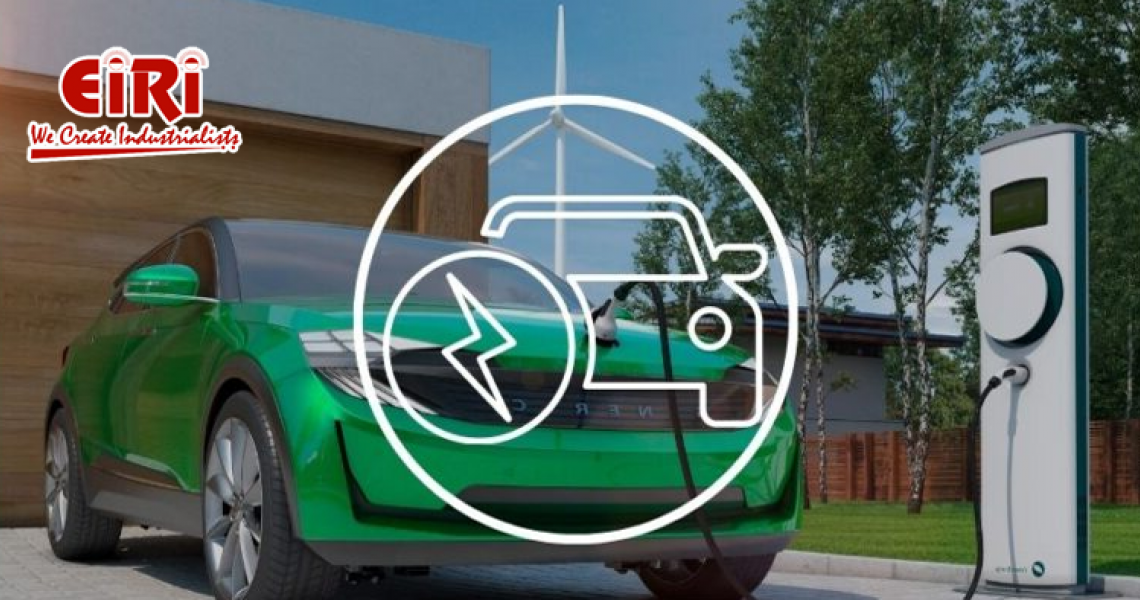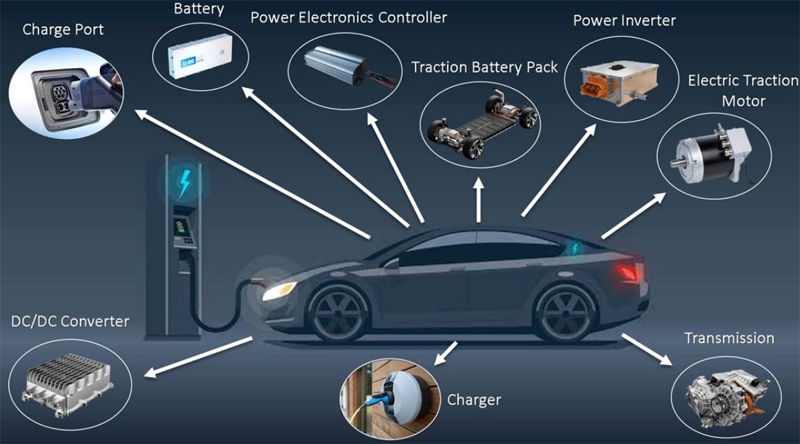Electric Vehicle Parts and Component (EV Spare Part Manufacturing Business)

The electric vehicle (EV) industry is currently undergoing a groundbreaking evolution propelled by heightened environmental awareness and cutting-edge technological advancements. The momentum in this sector is reflected in the valuation of the global electric vehicle parts and components market, which, as of 2022, stands at a substantial USD 164 billion. This remarkable figure is underpinned by a forecasted Compound Annual Growth Rate (CAGR) of 22.5%, showcasing the robust trajectory of the electric vehicle market. As we look ahead, projections paint a compelling picture, indicating that the market is poised to experience an unprecedented surge, reaching an estimated valuation of USD 1,242.85 billion by the year 2032. This forecast not only underscores the soaring demand for electric vehicles but also emphasizes the integral role played by the associated components in shaping the future of the automotive industry. The convergence of environmental consciousness and technological progress is steering the electric vehicle industry towards a transformative era, where sustainability and innovation intersect to redefine the landscape of transportation.
List of EV Spare Parts
Electric vehicles rely on a myriad of sophisticated components to function seamlessly. Key spare parts include the motor, collector, battery, solar panels, fuel cells, generator, displays, brakes, and other essential elements. These components work in unison to harness and store electrical energy, facilitating the operation of electric vehicles. Noteworthy innovations in battery electric vehicles, plug-in hybrid electric vehicles, and hybrid range extender electric vehicles underscore the dynamic nature of the EV industry.
Electric vehicles (EVs) are intricate systems that incorporate a diverse array of sophisticated spare parts to ensure optimal functionality. Understanding the key components is crucial for comprehending the complexity and innovation within the electric vehicle industry.
Motor: The motor is the powerhouse of an electric vehicle, responsible for converting electrical energy from the battery into mechanical energy that propels the vehicle. Electric motors are known for their efficiency and instant torque delivery, contributing to the overall performance of EVs.
Collector: The collector system plays a vital role in charging the electric vehicle's battery. It gathers electrical energy generated during processes like regenerative braking and transfers it back to the battery for storage and later use.
Battery: The battery is the heart of an electric vehicle, storing electrical energy to power the motor. Advanced lithium-ion batteries are commonly used in EVs, providing high energy density and longer driving ranges.
Solar Panels: Some electric vehicles integrate solar panels into their design to harness solar energy and convert it into electricity. While solar panels might not solely power the vehicle, they contribute to charging the auxiliary systems, enhancing overall energy efficiency.
Fuel Cells: In hydrogen fuel cell electric vehicles (FCEVs), fuel cells generate electricity through a chemical reaction between hydrogen and oxygen, powering the electric motor. Fuel cells offer a clean and sustainable alternative to traditional batteries.
Generator: In hybrid vehicles, a generator, often integrated with an internal combustion engine, can recharge the battery or directly power the electric motor. This hybrid approach provides flexibility and extended range.
Displays: EVs feature advanced display systems that provide drivers with essential information about the vehicle's performance, battery status, and energy consumption. Touchscreens and digital interfaces are common in modern electric vehicles.
Brakes: Electric vehicles often use regenerative braking systems that capture and convert kinetic energy back into electrical energy, improving overall efficiency. Traditional friction brakes are still present but are complemented by regenerative braking.
Other Essential Components: Various other components, such as inverters, power electronics, and cooling systems, contribute to the seamless operation of electric vehicles. Inverters, for example, convert direct current (DC) from the battery to alternating current (AC) for the motor.
These spare parts collectively form a sophisticated ecosystem, enabling electric vehicles to deliver a sustainable and efficient mode of transportation. The continuous innovation in battery technologies, charging infrastructure, and overall EV design reflects the dynamic nature of the electric vehicle industry. As the demand for EVs rises, manufacturers and suppliers are likely to focus on further advancements and optimizations in these key spare parts.
EV Spare Parts Current Global and India Market
The current global market for electric vehicle spare parts reflects a thriving industry with substantial value and promising growth prospects. As of now, the market is valued at USD 122.53 billion, and it is expected to experience a robust surge, reaching USD 318.47 billion. This growth trajectory is underlined by a compelling compound annual growth rate (CAGR) exceeding 21.05% throughout the forecast period.

The noteworthy aspect of this market's resilience is evident in its ability to withstand the challenges posed by the COVID-19 pandemic. Despite the disruptions and uncertainties brought about by the pandemic, the demand for electric vehicle parts has not only persevered but has also exhibited significant growth. This resilience underscores the adaptability of the electric vehicle industry and its capacity to navigate through unforeseen challenges.
In terms of regional dynamics, the Asia-Pacific market emerges as a focal point of growth, encompassing countries such as India. The region's growth is propelled by several factors. Firstly, increased technological development plays a pivotal role, fostering advancements in electric vehicle components. The integration of cutting-edge technologies contributes to the overall efficiency and performance of electric vehicles, driving the demand for related spare parts.
Furthermore, the surge in manufacturing and production of electric vehicles in the Asia-Pacific region contributes to the growth of the spare parts market. As more electric vehicles are introduced to the market, the demand for quality spare parts rises in tandem, presenting opportunities for suppliers and manufacturers in the industry.
The integration of EV components aligns with the region's commitment to sustainable transportation solutions. Governments and industries in the Asia-Pacific region, including India, are recognizing the environmental benefits of electric vehicles and are actively supporting initiatives that promote their adoption. Increased investment in research and development, advanced technologies, and infrastructure development further propels the market's expansion.
In summary, the current global market for electric vehicle spare parts is not only substantial but also displays a promising trajectory for the future. The resilience demonstrated in the face of challenges, coupled with the growth drivers in the Asia-Pacific region, positions the electric vehicle spare parts market as a key player in the broader landscape of sustainable and innovative transportation solutions.
Market Opportunities in the Electric Vehicle (EV) Industry:
Increased Demand and Sales of Electric Vehicles:
Growth Factor: The global shift toward sustainable and eco-friendly transportation solutions is a significant driver for the increased demand and sales of electric vehicles. Factors such as rising concerns over environmental pollution, coupled with the enactment of stringent emission norms by governments globally, have accelerated the adoption of electric vehicles.
Opportunities: As the demand for electric vehicles continues to rise, there is a parallel surge in the demand for associated parts and components that are integral to the functioning of these vehicles. This creates opportunities for manufacturers and suppliers in the electric vehicle parts market to meet the growing requirements of an expanding electric vehicle market.
Advancements in Technology:
Growth Factor: Continuous innovations in battery technology, autonomous driving features, and overall improvements in the performance of electric vehicles are contributing to the dynamic landscape of the EV industry. Technological advancements enhance the capabilities and efficiency of electric vehicles, making them more appealing to consumers.
Opportunities: The evolving technological landscape opens up opportunities for the development of innovative electric vehicle parts and components. Manufacturers can capitalize on the demand for cutting-edge technologies that improve the range, efficiency, and overall performance of electric vehicles.
Government Initiatives:
Growth Factor: Governments across the globe are actively investing in electric mobility projects as part of broader initiatives to combat climate change and reduce greenhouse gas emissions. These initiatives include incentives, subsidies, and infrastructure development to support the adoption of electric vehicles.
Opportunities: The significant support from governments creates favorable conditions for manufacturers and suppliers in the EV parts market. Increased investments and encouragement for both automobile manufacturers and consumers provide a conducive environment for the growth of the electric vehicle parts and components industry.
The market opportunities in the electric vehicle industry are driven by the increased demand for electric vehicles, advancements in technology, and supportive government initiatives. Manufacturers and suppliers in the electric vehicle parts market stand to benefit by aligning their strategies with these growth factors, catering to the evolving needs of the electric vehicle market and contributing to the broader goals of sustainability and environmental conservation.
Challenges and Restraints
Rapid Pace of Technological Advancements:
Constant adaptation and innovation are required to keep up with evolving technological requirements, posing a challenge to industry players.
High Costs Associated with Components:
The high costs, particularly related to batteries, present a barrier to mass adoption and require efforts to achieve price reductions and economies of scale.
Limited Charging Infrastructure:
The limited infrastructure for charging and concerns about range anxiety continue to hinder widespread consumer acceptance of electric vehicles.
Market Trends
Increasing Investments in Electric Vehicles:
Major automobile manufacturers and players like Amazon are investing significantly in electric vehicles, indicating a strong growth trajectory for the market.
Global Sales and Market Share:
Electric car markets are witnessing exponential growth, with global sales exceeding 10 million in 2022. China dominates the market, followed by Europe and the United States.
Emerging EV Markets:
Emerging electric vehicle markets in India, Thailand, and Indonesia are experiencing growth, supported by government incentives and strengthening policy support schemes.
In conclusion, the electric vehicle parts and components market is at the forefront of a transformative era in the automotive industry. With technological advancements, increasing global sales, and a shift toward sustainable transportation, the future of electric vehicles looks promising. Manufacturers, investors, and policymakers need to collaborate to address challenges, seize opportunities, and contribute to the evolution of the electric vehicle ecosystem.










